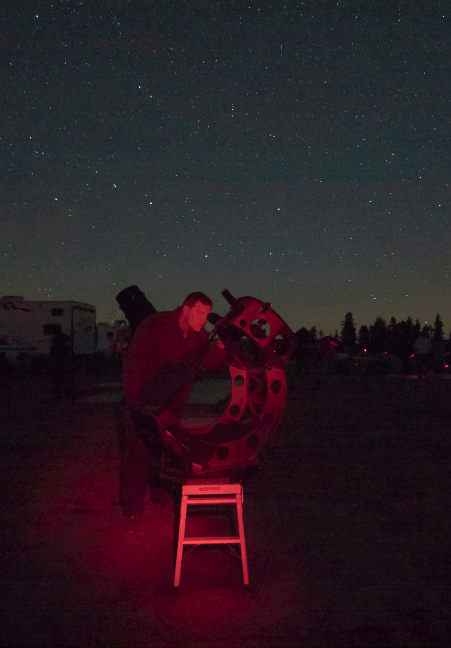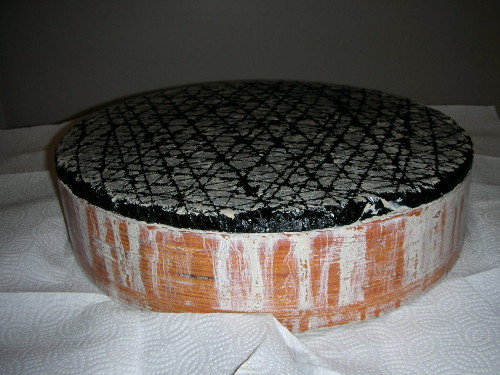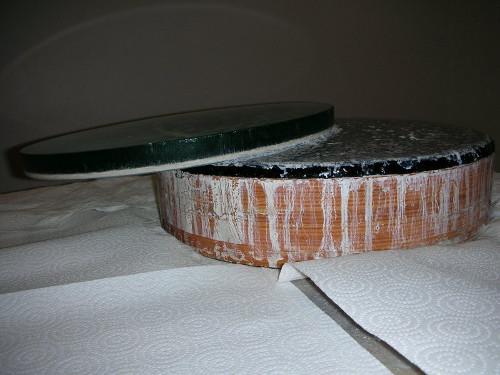

Though our species isn't the only toolmaker on the planet, we have taken toolmaking to new heights. Stone tools go back 3.3 million years. Pounding, scraping, knapping, grinding combined with fire, heat, melting leads us today to grinding telescope mirrors from glass.
Making a telescope mirror is one of the most satisfying and sublime joys you will experience. It's also arguably the most accurate surface made by man or machine. If the mirror is expanded to the size of a football field, then the mirror's surface will be smooth to 1/1000 inch or 1/30 millimeter! Our experience begins with the varied sensations of touch and sound during grinding and carries through to the cerebral challenge of parabolizing the mirror to perfectly focus the light. Our experience continues by placing the mirror in a telescope to contemplate the mysteries of the universe and the meaning of life.
Here I am enjoying pinpoint star images at the eyepiece during the 2011 Oregon Star Party. And here is my 13 inch [33cm] f/3.0 meniscus plate glass mirror, 1 inch [2.5cm] thick, sagitta of 0.27 inches [7mm], ready for aluminum coating.


Comparing mirror making to rock climbing from a PBS interview.
MOYERS: What drew you to climbing?
HOUSTON: It's a beautiful thing to do. You're surrounded by beauty. No matter whether it's a storm, or a sunny day, or clouds, or not, the mountains are simply beautiful. I just liked climbing. I like the feel of the rocks.
MOYERS: The feel of the rocks?
HOUSTON: Rock feels good, yes.
MOYERS: How? I mean, you're talking to somebody who doesn't climb.
HOUSTON: Well, rock climbing; you have a sense of the rock. Almost as though it were a living thing under your hands and you learn to explore. I've never been a great climber. I'm just a competent climber and I know my limits. But I love getting out and doing it.
Our mirror should focus the light as sharply as possible. We want the stars to be pinpoints in the eyepiece at our telescope's highest powers, tight dots in our digital images and we want our planetary and lunar views to be richly detailed.
You'll test your telescope mirror finding areas, called zones, that are slightly high to polish down. You'll also test your mirror for smoothness, all using a simple tester made from inexpensive easy to obtain materials.
I'm purposefully side stepping discussions of the Rayleigh Criteria et al. Don't be sucked into the online whirlpools swirling around wave ratings, secondary sizes, contrast, super polishing compounds, exotic testers and so on - the list is endless.
Suffice to say that if you concentrate on producing a smooth mirror that focuses sharply and properly baffle your telescope for best contrast then you'll have a telescope that you can enjoy every night and that will pass all the tests. Here is a mirror smooth from center all the way to the edge illustrated by Ronchigrams of a 13 inch [33cm] f/3.0 mirror, 100 lines per inch [4 lines per mm] grating:


To finish a project doing only the work necessary at each stage, it is useful to imagine the finished product and determine what needs to be done. This begats an earlier stage that we can similarly treat. Eventually we reach the beginning of the project, with a clear path of dependencies or what needs to be done in order to accomplish the stages. The four milestones in reverse for completing a mirror are: parabolizing, polishing, fine grinding, and curve generation. Each stage depends on the previous stage being completed correctly.
Here are the four steps in sequence
No matter how complicated and how many ins and outs you consider, never forget that mirror making boils down to these four essential steps. It need not be that hard! It can be a lot of fun and be deeply satisfying!
Here is an introduction to the steps.
Rough Grinding
Unless the mirror comes pre-generated, the initial curve will have to be ground into the mirror. A ring tool of half the diameter of the mirror used on top of the mirror's flat face with the coarsest grit will rapidly grind a spherical curve into the mirror.
Grinding a 6 inch [15cm] mirror to F/2.8 using a ring tool.
Rough grinding the backside
Thin mirrors require a regularly curved backside. The backside should be ground through least 220 silicon carbide to preclude the Twyman Effect. We've found that with ultra-thin mirrors, for example a 16.25x3/8 inch [410x10mm], that the Twyman Effect causes astigmatism. When the back side was ground with 220 grit, the astigmatism disappeared.
The tool
I use plaster tools cast to the curved mirror with unglazed ceramic tiles glued to the face. Stroking the tool on top (called TOT) of the mirror, I rotate the mirror underneath 30-45 degrees every fifteen minutes. This prevents astigmatism from occurring via print through from the mirror's backside. Mirror on top (called MOT) can also be used to avoid astigmatism, since the tool supports the mirror, but the grit seems to fall down between the tiles requiring more grit and wets to complete.
6 inch [15cm] tiled tool
Fine grinding
A series of ever smaller grits are employed in order to repair the damage caused by rough grinding, concluding with aluminum oxide which leaves much smaller pits and fewer fractures compared to the silicon carbide. This stage is called fine grinding.
I like to use three grit sizes, 220 silicon carbide, 500 silicon carbide, and 9 micron aluminum oxide. Another good sequence is 220 silicon carbide followed by 25 micron aluminum oxide concluding with 9 micron oxide. Grit of a particular size comes with a wide distribution of particle sizes. Typical are 20% of particles that are twice the stated size. Comparing particle sizes of 400 grit with 500 grit, the size ratio looks to be 4:5. But when looking at the 20% particle distribution, it is a nearly identical 9:10 ratio. Consequently it duplicates effort to run through a long series of grit sizes, as commonly practiced: 220, 300, 400, 500, 600, 25 micron, 15 micron, 12 micron, 9 micron, and 5 micron aluminum oxides.
The third and final grit that I use is 9 micron aluminum oxide. Ending with 9 micron instead of 5 or 3 micron reduces the chance of sticking on large blanks and controls scratching. Comparing 9 micron to 5 micron looks to be a nearly two times reduction in glass pit depth, but looking at the 20% particle distribution, the reduction is only one-third.
Polishing
To achieve this preparatory to parabolizing stage, the mirror is polished to a shape that is smooth and spherical. The rate of glass removal during polishing is exceedingly small. It could take us fifty years of non-stop polishing if we were to start with a flat piece of glass, hence the preparatory stages of rough then fine grinding.
Polishing with a pliable material like pitch (first used by Isaac Newton three hundred years ago) results in a smooth polished surface, accurate to a fraction of a wavelength of light, that is ready to begin parabolizing. The act of polishing is both a mechanical and a chemical process.
Pictured is an oversized 14 inch [36cm] pitch lap for 13 inch mirror; note the micro-facetting in place of channels. Next I am parabolizing the 13 inch [33cm] f/3.0 mirror with extremely long 'mirror on top' strokes.


Parabolizing
In order to make an indistinguishable from perfect star image, the mirror surface must be accurate to a small fraction of the wavelength of visible light. The stage of adjusting the mirror surface to a paraboloidal shape by preferential polishing is called parabolizing. To begin this phase, the mirror surface should be smooth and spherical.
More success comes from seeing mirror making as a process. For example, testing a mirror isn't just testing that mirror, instead testing should be about informing the process. Is my parabolization process working? How should I adjust it? Too often the mirror maker is tempted into one-off wild forays, far from the process, that rarely works.
My first time I understand this was a kid reading Texereau, where he wrote two passages translated as:
1) 'Before attempting a local retouching step as such, we try to eliminate the defect automatically, by continuing normal polishing at least an hour (checking the condition of the tool and stroke carefully).' He then goes on to lay out the understanding necessary for a parabolizing process, he then describes his process of parabolizing, followed by a huge diversion into the Foucault test and mathematical analysis.
2)The key sentence is in the middle of his description of the parabolizing process, 'If we could continue always to have an 'average' operator, we would obtain almost at once, in moderate focal ratios, a parabola to a very close approximation. The author's group has parabolized a number of mirrors 'automatically,' in effect, by using a team of four or five operators all applying the 'same' stroke. The stroke used was shorter than normal for parabolizing, ie, not more than two-thirds the diameter. Total parabolizing time was about an hour, the operators being changed every 10 minutes.'
And finally Texereau's concluding remarks. 'The most exacting stage in the making of the telescope is now completed. The author would be distressed if any reader, at first attracted to optical glass working, has been turned away by the many details that we have here presented. Surely, not every detail is indispensable for a satisfactory or even a perfect mirror. We have felt, however, that every amateur who has the ability to do so has also, in a sense, the duty to make a perfect mirror, and should be given every opportunity to achieve such a result. The discipline is an excellent one. It makes the amateur both worthy of owing a power telescope and better prepared for that far more delicate task: observing the stars to advantage in an atmosphere that is constantly beset with perturbation.'
- Jeff Baldwin's telescope making pages http://www.jeffbaldwin.org/atm.htm
- Bell's The Telescope
- Richard Berry's Build Your Own Telescope
- Richard Berry and David Kriege's The Dobsonian Telescope
- Serge Bertorello's The creation of a plane mirror
- John Brashear's The Production of Optical Surfaces from Summarized Proceedings and a Directory of Members, 1871, http://tinyurl.com/pn3crhl
- Sam Brown's All About Telescopes
- William J. Cook's The Best of Amateur Telescope Making Journal
- John Dobson's How and Why to Make a User-Friendly Sidewalk Telescope
- Myron Emerson's Amateur Telescope Mirror Making
- GAP 47's machines summary
- Paul Hasluck's Glass Working By Heat And By Abrasion
- David Harbour's Understanding Foucault
- Albert Highne's Portable Newtonian Telescopes
- Neale E. Howard's Standard Handbook for Telescope Making
- Albert G. Ingall's Amateur Telescope Making, Volumes 1-3
- Henry King's The History of the Telescope
- Italian telescope making
- Karine and Jean-Marc Lecleire's A Manual for Amateur Telescope Makers
- Mike Lockwood's mirror making and publications
- Allyn J. Thompson's Making Your Own Telescope
- Allan Mackintosh's Advanced Telescope Making Techniques - Optics, Advanced Telescope Making Techniques - Mechanical
- Daniel Malacara's Optical Shop Testing
- George McHardie's Preparation of Mirrors for Astronomical Telescopes
- Robert Miller and Kenneth Wilson's Making and Enjoying Telescopes
- James Muirden's Beginner's Guide to Astronomical Telescope Making
- Jason Nelson and Shawn Iles' Fabrication of ultralow-roughness surfaces: The Beilby layer
- Donald Osterbrock's Ritchey, Hale, and Big American Telescopes
- Henry Paul's Telescopes for Skygazing
- Damian Peach's analysis of aperture, optical quality, central obstruction and seeing
- Robert Piekiel's Testing and Evaluating the Optics of Schmidt-Cassegrain Telescopes, Making Schmidt-Cassegrain Telescope Optics, ATM's Guide to Setting up a Home Optics Shop, Tips for Making Optical Flats
- Norman Rember's Making a Refractor Telescope
- Sherman Shultz's The Macalaster Four-Goal System of Mirror Making and the Ronchi Test, Telescope Making #9
- John Strong's Procedures in Experimental Physics
- Scientific American's The Amateur Astronomer
- H.R.Suiter's Star Testing Astronomical Telescopes
- Telescope Making magazine (no longer published)
- Jean Texereau's How to Make a Telescope
- Stephen J. Tonkin's Amateur Telescope Making
- John Walley's Your Telescope, a Construction Manual
- Wilkins and Moore's How to Make and Use a Telescope
- Stellafane Amateur Telescope Making pages http://stellafane.org/stellafane-main/tm/atm/ (comprehensive collection of links to web articles)
- Advanced mirror makers who are also experienced observers
(end of introduction)
For more see